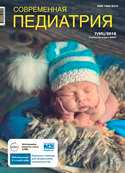Современные принципы наружной терапии атопического дерматита у детей
DOI:
https://doi.org/10.15574/SP.2018.95.78Ключевые слова:
атопический дерматит, дети, наружная терапияАннотация
В структуре аллергических заболеваний особое место занимает атопический дерматит, поскольку он: является одним из наиболее частых и первых проявлений аллергии, нередко в дальнейшем трансформируется в другие формы аллергии, существенно снижает качество жизни детей независимо от возраста, требует длительного, этапного лечения и реабилитации. Несмотря на значительное количество научных работ, остаются трудности в определении лечебной тактики при атопическом дерматите у детей. В соответствии с международными программными документами ICCAD (International Consensus Conference on Atopic Dermatitis), EAACI (European Academy of Allergy and Clinical Immunology), AAAAI (American Academy of Allergy, Asthma & Immunology), PRACТALL (Practical Allergology Consensus Report), в лечении атопического дерматита ведущее место занимает наружная терапия, которая требует индивидуального подхода и ежедневного наблюдения за состоянием кожи. Наружная терапия заключается в местном применении эмолентов, топических глюкокортикостероидов, антагонистов рецепторов лейкотриенов, антигистаминных препаратов, ингибиторов кальциневрина, а в случае осложненного клинического течения заболевания — дополнительного применения антибактериальных, противогрибковых, противовирусных лекарственных средств.
Библиографические ссылки
Balabolkin II, Bulhakova VA, Yeliseyeva TI. (2017). Atopic dermatitis in children: immunological aspects of pathogenesis and therapy. Pediatrics. 2:128–131.
Besh LV. (2017). Atopic dermatitis in children: what do pediatricians need to know today? Health of Ukraine. 7 (404): 20–21.
Ministry of Healthcare of Ukraine. (2012). Adapted clinical guidelines for the diagnosis, prevention and treatment of atopic dermatitis. Kyiv:76.
Mochulska OM. (2017). Comparative characteristic of clinical efficacy of different treatment schemes at atopic dermatitis in children, features of using specific immunological tolerance induction. Actual questions of pediatrics, obstetrics and gynecology. 1:5–11.
Nevozynskaia ZA, Plieva KT, Korsunskaia IM. (2016). Possibilities of control over the course of atopic dermatitis. Consilium Medicum. Dermatology.1:49–53.
Okhotnikova OM, Yakovleva NY, Chernysh YR. (2016). Modern aspects of external anti-inflammatory therapy of atopic dermatitis in children. Sovremennaya pediatriya. 2(74): 92—99. https://doi.org/10.15574/SP.2016.74.92
Samtsov AV, Sokolovskyi EV, Araviyskaia EA. (2015). Recommendations for the treatment of atopic dermatitis (atopic eczema) of the American Academy of Dermatology, the European Academy of Dermatovenereology and the Russian Society of Dermatovenereology and Cosmetology. Expert opinion. Herald of Dermatology and Venereology. 6: 11–16.
Slavianskaya TA, Derkach VV. (2016). The strategy of treatment atopic dermatitis: from the past to the future. Allergology and Immunology. 1(17):4–11.
Tyazhka OV. (2013, March). Atopic dermatitis in children. Health of Ukraine. Thematic issue: 30–31.
Chopiak VV, Kaliuzhna LD, Stepanenko VI et al. (2016). Atopic dermatitis: an adapted clinical approach, based on evidence. State Expert Center of the Ministry of Health in Ukraine. Kyiv:112.
Anto JM, Bousquet J, Akdis M et al. (2017). Mechanisms of the Development of Allergy (MeDALL): Introducing novel concepts in allergy phenotypes. Journal of Allergy and Clinical Immunology. 139;2: 388—399. https://doi.org/10.1016/j.mod.2017.04.104
Chan S, Cornelius V, Chen T et al. (2017). Atopic Dermatitis Anti-IgE Paediatric Trial (ADAPT): the role of anti-IgE in severe paediatric eczema: study protocol for a randomised controlled trial. Trails. 18; 1:136.
Czarnowicki T, Krueger JG, Guttman-Yassky E. (2017). Novel concepts of prevention and treatment of atopic dermatitis through barrier and immune manipulations with implications for the atopic march. Journal of Allergy and Clinical Immunology. 139;6:1723—1734. https://doi.org/10.1016/j.jaci.2017.04.004; PMid:28583445
Danby SG, Chalmers J, Brown K et al. (2016). A functional mechanistic study of the effect of emollients on the structure and function of the skin barrier. British Journal of Dermatology. 175;5:1011—1019. https://doi.org/10.1111/bjd.14684; PMid:27097823
Drucker AM. (2017). Atopic dermatitis: Burden of illness, quality of life, and associated complications. Allergy & Asthma Proceedings. 38;1:3—8. https://doi.org/10.2500/aap.2017.38.4005; PMid:28052794
Edwards C. (2016). Measurements of structure and function of skin: emollient effects on atopic dermatitis. British Journal of Dermatology. 175;5:868—869. https://doi.org/10.1111/bjd.14942; PMid:27790690
Furue M, Chiba T, Tsuji G et al. (2017). Atopic dermatitis: immune deviation, barrier dysfunction, ige autoreactivity and new therapies. Allergology International. 66;3:398—403. https://doi.org/10.1016/j.alit.2016.12.002; PMid:28057434
Gittler JK, Wang JF, Orlow SJ. (2017). Bathing and associated treatments in atopic dermatitis. American Journal of Clinical Dermatology. 18;1:45—57. https://doi.org/10.1007/s40257-016-0240-2; PMid:27913962
Heratizadeh A, Werfel T. (2016). Anti-inflammatory therapies in atopic dermatitis. Allergy. 71;12:1666—1675. https://doi.org/10.1111/all.13065; PMid:27735066
Jonathan I Silverberg, Silverberg N. (2017). Atopic Dermatitis, an Issue of Dermatologic Clinics. Elsevier. Health Science Division. 35:33.
Kamata Y, Tominaga M, Takamori M. (2016). Itch in atopic dermatitis management. Current Problems in Dermatology. 50:86—93. PMid:27578076
Kido-Nakahara M, Furue M, Ulzii D et al. (2017). Itch in atopic dermatitis. Immunology and Allergy Clinics of North America. 37;1:113—122. https://doi.org/10.1016/j.iac.2016.08.007; PMid:27886901
Kim JP, Chao LX, Simpson EL, Silverberg JI. (2016). Persistence of atopic dermatitis (AD): A systematic review and meta-analysis. Journal of the American Academy of Dermatologyol. 75; 4: 681—687. https://doi.org/10.1016/j.jaad.2016.05.028; PMid:27544489 PMCid:PMC5216177
Lee GB, Fonacier L. (2017). Difficult to manage atopic dermatitis. Journal of Allergy and Clinical Immunology: in Practice. 5;1:207—208. https://doi.org/10.1016/j.jaip.2016.09.007; PMid:28065338
Metz M, Staubach P. (2016). Itch management: topical agents. Current Problems in Dermatology. 50: 40—45. PMid:27578070
Ohtsu H, Seike M. (2017). Histamine and histamine receptors in allergic dermatitis. Handbook of Experimental Pharmacology. 241: 333—345. https://doi.org/10.1007/164_2016_9; PMid:27787718
Silverberg NB, Duran-McKinster C. (2017). Special Considerations for Therapy of Pediatric Atopic Dermatitis. Dermatologic Clinics. 35; 3: 351—363. https://doi.org/10.1016/j.det.2017.02.008; PMid:28577804
Wert AF, Posa D, Tsilochristou O, Schwerk N. (2016). Treatment of allergic children — where is the progress (for the practicing allergist)? Pediatric Allergy and Immunology. 27;7:671—681. https://doi.org/10.1111/pai.12653; PMid:27614100

